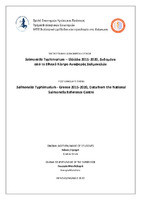Salmonella Typhimurium – Ελλάδα 2015-2020, Δεδομένα από το Εθνικό Κέντρο Αναφοράς Σαλμονελών
Salmonella Typhimurium - Greece 2015-2020, Data from the National Salmonella Reference Centre

Keywords
Salmonella ; Typhimurium ; DT104 ; Ελλάδα ; ΕΟΔΥ ; Gallus gallus ; Μονοφασική ; Επιπολασμός ; EFSA ; ECDCAbstract
Εισαγωγή: Σύμφωνα με τα επίσημα στοιχεία του ΕΟΔΥ, η Salmonella enterica enterica
ορότυπος Τyphimurium είναι ένας από τους 5 πιο συχνά αναγνωρισμένους
ορότυπους που απομονώνονται στην Ελλάδα. Με αυτό το δεδομένο, η επιτήρησή
της, όπως και ο έλεγχος της δηλούμενης επίπτωσής της, αποκτούν ζωτική σημασία
για τη δημόσια υγεία, αλλά και με την έννοια της Ενιαίας Υγείας, μιας και η
σαλμονέλωση είναι ζωοανθρωπονόσος.
Σκοπός: Να παρουσιαστούν βασικά στοιχεία για τη σαλμονέλα και να αναλυθεί η
τάση του ορότυπου Salmonella Typhimurium στην Ελλάδα κατά το διάστημα 2015-
2020 με βάση τα δεδομένα του Εθνικού Κέντρου Αναφοράς Σαλμονελώσεων. Επίσης
να γίνει σύγκριση των ελληνικών δεδομένων με τα αντίστοιχα ευρωπαϊκά κατά την
ίδια χρονική περίοδο, όπως και αποτελέσματα ελέγχων σε κοπάδια πουλερικών.
Μέθοδος: Με τα δεδομένα του ΕΚΑΣ και των ετήσιων αναφορών του EFSA και ECDC
έγινε στατιστική σύγκριση μέσω γραφημάτων και πινάκων που δημιουργήθηκαν με
το Microsoft Excel.
Αποτελέσματα: Στην Ευρώπη συνολικά παρατηρείται μια μείωση στην εμφάνιση
κρουσμάτων σαλμονέλας γενικά και ειδικά χωρίς όμως να ακολουθείται η ίδια τάση
και στην Ελλάδα. Η αντιμικροβιακή αντοχή από υψηλά επίπεδα βαίνει συνεχώς
μειούμενη στην Ευρώπη, ενώ στην Ελλάδα κινείται πάντα σε χαμηλά ποσοστά. Ο
έλεγχος επιπολασμού στα πουλερικά πιάνει τους στόχους σε Ελλάδα και Ευρώπη
χωρίς να μειώνεται αντίστοιχα η εμφάνιση κρουσμάτων σε ανθρώπους.
Συμπεράσματα: Η επίπτωση της Salmonella Typhimurium έχει μειωθεί στο χρονικό
όριο της μελέτης , απαιτείται όμως περαιτέρω έλεγχος αφενός για να εντοπισθούν
άλλες αποθήκες (reservoir) του βακτηρίου και αφετέρου για να προληφθούν
επιδημικά ξεσπάσματα.
Abstract
Introduction: According to the official data of EODY, Salmonella enterica enterica
serotype Typhimurium is one of the 5 most frequently recognized serotypes isolated
in Greece. Given this fact, its surveillance, as well as the control of its declared impact,
acquire vital importance for public health, but also in the concept of One Health, since
salmonellosis is zoonotic.
Purpose: To present basic information about salmonella and to analyze the trend of
the Salmonella Typhimurium serotype in Greece during the period 2015-2020 based
on the data of the National Salmonellosis Reference Center. Moreover. to compare
the Greek data with the corresponding European ones during the same period of time,
as well as the results of checks on poultry flocks.
Method: A statistical comparison was made between the data of EKAS and the annual
reports of EFSA and ECDC through graphs and tables created with Microsoft Excel.
Results: In Europe as a whole there is a reduction in the occurrence of Salmonella
cases in general whereas Greece does not follow the same trend. Antimicrobial
resistance from alarmingly high levels is constantly decreasing in Europe, while in
Greece it is always at low rates. Prevalence control in poultry is reaching the targets
in Greece and Europe without a corresponding decrease in the occurrence of cases in
humans.
Discussion: The incidence of Salmonella Typhimurium has decreased in the time limit
of the study, but further control is required on the one hand to identify other
reservoirs of the bacterium and on the other hand to prevent epidemic outbreaks.

